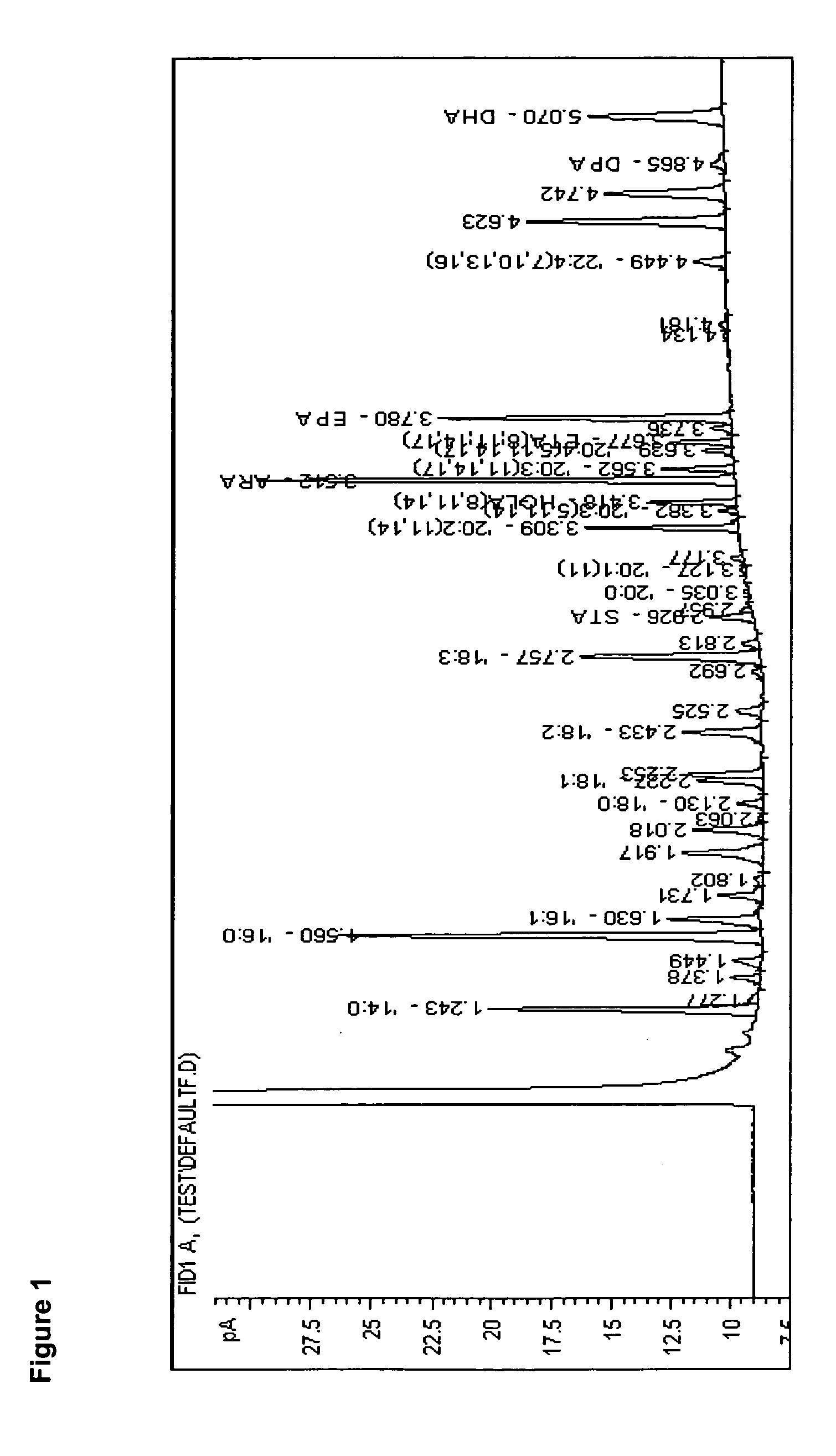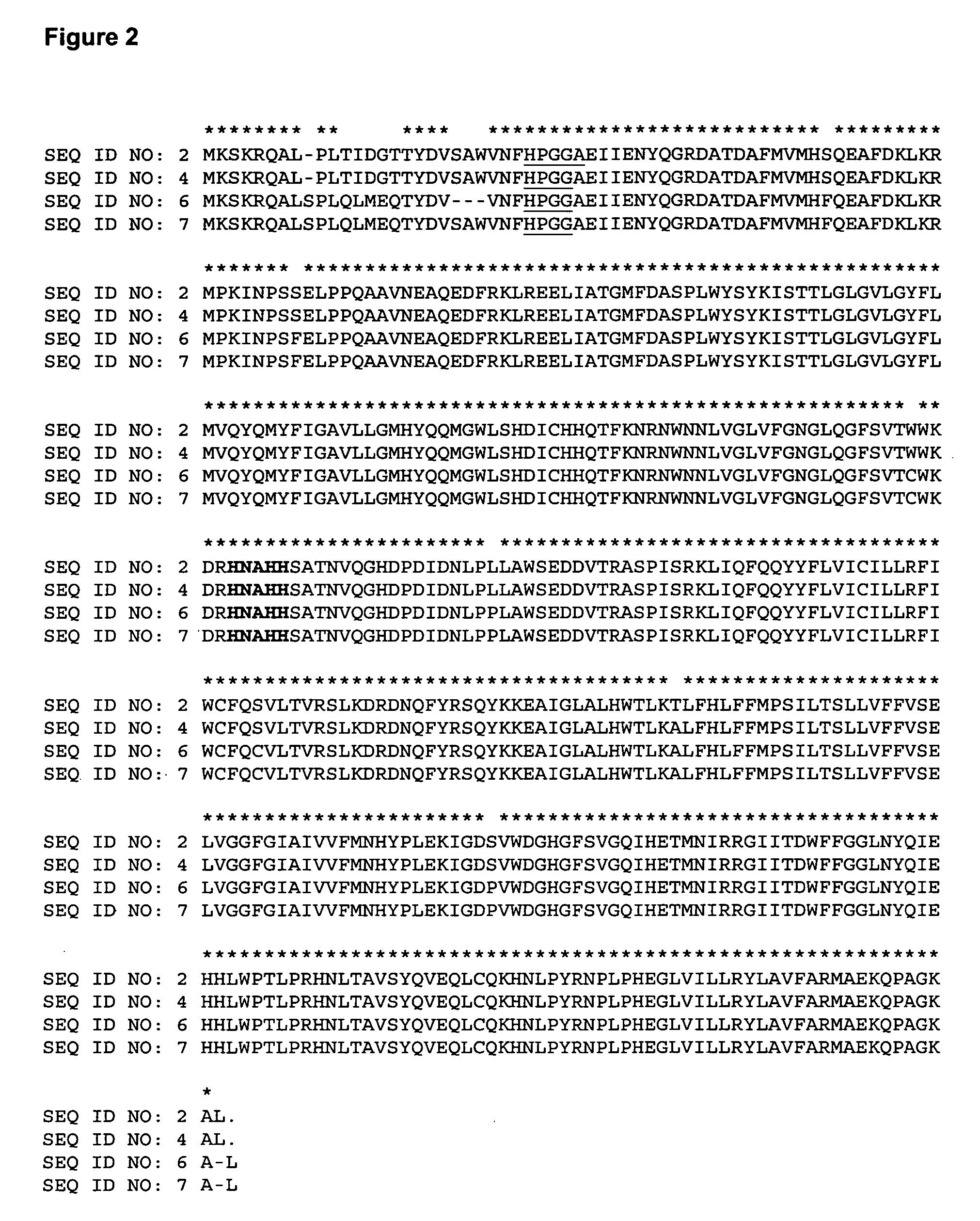Delta-8 desaturase and its use in making polyunsaturated fatty acids
a polyunsaturated fatty acid and desaturase technology, applied in the field of polyunsaturated fatty acid production, can solve the problems of limited biosynthesis of long-chain pufas, insufficient study of pufas from natural sources and from chemical synthesis, and insufficient commercial needs, and achieves largely unsuccessful efforts to improve the yield of oil or the ability to control the characteristics of oil composition produced
- Summary
- Abstract
- Description
- Claims
- Application Information
AI Technical Summary
Problems solved by technology
Method used
Image
Examples
example 1
Synthesis and Expression of a Codon-Optimized Delta-8 Desaturase Gene in Yarrowia lipolytica
[0334] In order to express the delta-8 desaturase gene of Euglena gracilis (SEQ ID NOs:5 and 6, GenBank Accession No. AAD45877) in Yarrowia lipolytica, the codon usage of the delta-8 desaturase gene was optimized for expression in Y. lipolytica. A codon-optimized delta-8 desaturase gene (designated “D8S-1”, SEQ ID NO:48) was designed, based on the published sequence of Euglena gracilis (SEQ ID NO:5), according to the Yarrowia codon usage pattern (WO 2004 / 101753), the consensus sequence around the ‘ATG’ translation initiation codon, and the general rules of RNA stability (Guhaniyogi, G. and J. Brewer, Gene 265(1-2):11-23 (2001)). In addition to the modification of the translation initiation site, 200 bp of the 1260 bp coding region were modified (15.9%). None of the modifications in the codon-optimized gene changed the amino acid sequence of the encoded protein (SEQ ID NO:6) except the second...
example 2
Euglena gracilis Growth Conditions, Lipid Profile and mRNA Isolation
[0346]Euglena gracilis was obtained from Dr. Richard Triemer's lab at Michigan State University (East Lansing, Mich.). From 10 mL of actively growing culture, a 1 mL aliquot was transferred into 250 mL of Euglena gracilis (Eg) Medium in a 500 mL glass bottle. Eg medium was made by combining: 1 g of sodium acetate, 1 g of beef extract (U126-01, Difco Laboratories, Detroit, Mich.), 2 g of Bacto®Tryptone (0123-17-3, Difco Laboratories) and 2 g of Bacto®Yeast Extract (0127-17-9, Difco Laboratories) in 970 mL of water. After filter sterilizing, 30 mL of Soil-Water Supernatant (Catalog #15-3790, Carolina Biological Supply Company, Burlington, N.C.) was aseptically added to produce the final Eg medium. Euglena gracilis cultures were grown at 23° C. with a 16 hr light, 8 hr dark cycle for 2 weeks with no agitation.
[0347] After 2 weeks, 10 mL of culture was removed for lipid analysis and centrifuged at 1,800×g for 5 min. T...
example 3
cDNA Synthesis and PCR of Euglena gracilis Delta-8 Desaturase
[0349] cDNA was synthesized from 765 ng of mRNA (Example 2) using the SuperScript™ Choice System for cDNA synthesis (Invitrogen™ Life Technologies, Carlsbad, Calif.) with the provided oligo(dT) primer according to the manufacturer's protocol. The synthesized cDNA was dissolved in 20 μL of water.
[0350] The Euglena gracilis delta-8 desaturase was amplified from cDNA with oligonucleotide primers Eg5-1 (SEQ ID NO:8) and Eg3-3 (SEQ ID NO:9) using the conditions described below.
[0351] cDNA (1 μL) from the reaction described above was combined with 50 pmol of Eg5-1, 50 pmol of Eg5-1, 1 μL of PCR nucleotide mix (10 mM, Promega, Madison, Wis.), 5 μL of 10×PCR buffer (Invitrogen), 1.5 μL of MgCl2 (50 mM, Invitrogen), 0.5 μL of Taq polymerase (Invitrogen) and water to 50 μL. The reaction conditions were 94° C. for 3 min followed by 35 cycles of 94° C. for 45 sec, 55° C. for 45 sec and 72° C. for 1 min. The PCR was finished at 72° ...
PUM
| Property | Measurement | Unit |
|---|---|---|
| Fraction | aaaaa | aaaaa |
Abstract
Description
Claims
Application Information
 Login to View More
Login to View More - R&D
- Intellectual Property
- Life Sciences
- Materials
- Tech Scout
- Unparalleled Data Quality
- Higher Quality Content
- 60% Fewer Hallucinations
Browse by: Latest US Patents, China's latest patents, Technical Efficacy Thesaurus, Application Domain, Technology Topic, Popular Technical Reports.
© 2025 PatSnap. All rights reserved.Legal|Privacy policy|Modern Slavery Act Transparency Statement|Sitemap|About US| Contact US: help@patsnap.com



